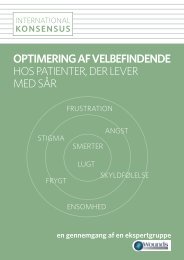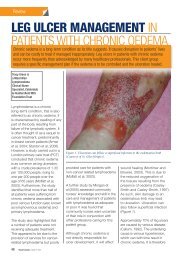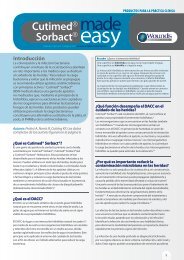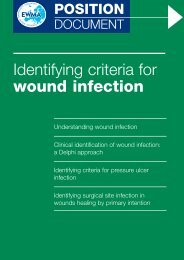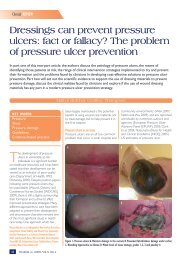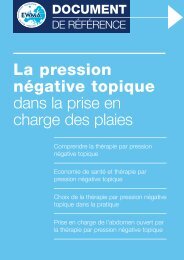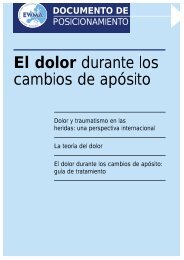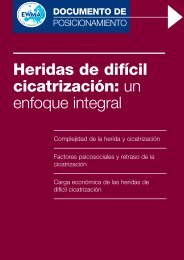best practice guidelines: wound management in diabetic foot ulcers
best practice guidelines: wound management in diabetic foot ulcers
best practice guidelines: wound management in diabetic foot ulcers
- No tags were found...
You also want an ePaper? Increase the reach of your titles
YUMPU automatically turns print PDFs into web optimized ePapers that Google loves.
AETIOLOGY OFDFUsAetiology of DFUsThe underly<strong>in</strong>g cause(s) of DFUs will have a significant bear<strong>in</strong>g on the cl<strong>in</strong>ical<strong>management</strong> and must be determ<strong>in</strong>ed before a care plan is put <strong>in</strong>to placeIn most patients, peripheral neuropathy andperipheral arterial disease (PAD) (or both)play a central role and DFUs are thereforecommonly classified as (Table 1) 26 : Neuropathic Ischaemic Neuroischaemic (Figures 2–4).Neuroischaemia is the comb<strong>in</strong>ed effectof <strong>diabetic</strong> neuropathy and ischaemia,whereby macrovascular disease and, <strong>in</strong>some <strong>in</strong>stances, microvascular dysfunctionimpair perfusion <strong>in</strong> a <strong>diabetic</strong> <strong>foot</strong> 26,27 .is <strong>in</strong>creas<strong>in</strong>g and it is reported to be a contributoryfactor <strong>in</strong> the development of DFUs<strong>in</strong> up to 50% of patients 14,28,33 .It is important to remember that even <strong>in</strong> theabsence of a poor arterial supply, microangiopathy(small vessel dysfunction)contributes to poor ulcer heal<strong>in</strong>g <strong>in</strong> neuroischaemicDFUs 34 . Decreased perfusion <strong>in</strong>the <strong>diabetic</strong> <strong>foot</strong> is a complex scenario andis characterised by various factors relat<strong>in</strong>gto microvascular dysfunction <strong>in</strong> addition toPAD 34 .FIGURE 2: Neuropathic DFUPERIPHERAL NEUROPATHYPeripheral neuropathy may predispose the<strong>foot</strong> to ulceration through its effects on thesensory, motor and autonomic nerves: The loss of protective sensation experiencedby patients with sensory neuropathyrenders them vulnerable to physical,chemical and thermal trauma Motor neuropathy can cause <strong>foot</strong>deformities (such as hammer toes andclaw <strong>foot</strong>), which may result <strong>in</strong> abnormalpressures over bony prom<strong>in</strong>ences Autonomic neuropathy is typicallyassociated with dry sk<strong>in</strong>, which can result<strong>in</strong> fissures, crack<strong>in</strong>g and callus. Anotherfeature is bound<strong>in</strong>g pulses, which isoften mis<strong>in</strong>terpreted as <strong>in</strong>dicat<strong>in</strong>g a goodcirculation 28 .Loss of protective sensation is a majorcomponent of nearly all DFUs 29,30 . It is associatedwith a seven–fold <strong>in</strong>crease <strong>in</strong> riskof ulceration 6 .DFUs usually result from two or more riskfactors occurr<strong>in</strong>g together. Intr<strong>in</strong>sic elementssuch as neuropathy, PAD and <strong>foot</strong> deformity(result<strong>in</strong>g, for example, from neuropathicstructural changes), accompanied by anexternal trauma such as poorly fitt<strong>in</strong>g <strong>foot</strong>wearor an <strong>in</strong>jury to the <strong>foot</strong> can, over time,lead to a DFU 7 .TABLE 1: Typical features of DFUs accord<strong>in</strong>g to aetiologyFeature Neuropathic Ischaemic NeuroischaemicSensation Sensory loss Pa<strong>in</strong>ful Degree of sensorylossCallus/necrosisWound bedFoot temperatureand pulsesCallus present andoften thickP<strong>in</strong>k and granulat<strong>in</strong>g,surrounded bycallusWarm with bound<strong>in</strong>gpulsesNecrosis commonPale and sloughywith poorgranulationCool with absentpulsesFIGURE 3: Ischaemic DFUFIGURE 4: NeuroischaemicDFUM<strong>in</strong>imal callusProne to necrosisPoor granulationCool with absentpulsesPatients with a loss of sensation will havedecreased awareness of pa<strong>in</strong> and othersymptoms of ulceration and <strong>in</strong>fection 31 .PERIPHERAL ARTERIAL DISEASEPeople with diabetes are twice as likely tohave PAD as those without diabetes 32 . Itis also a key risk factor for lower extremityamputation 30 . The proportion of patientswith an ischaemic component to their DFUOtherTypical locationPrevalence(based on 35 )Dry sk<strong>in</strong> andfissur<strong>in</strong>gWeight-bear<strong>in</strong>gareas of the <strong>foot</strong>,such as metatarsalheads, the heel andover the dorsum ofclawed toesDelayed heal<strong>in</strong>gTips of toes, nailedges and betweenthe toes and lateralborders of the <strong>foot</strong>35% 15% 50%High risk of<strong>in</strong>fectionMarg<strong>in</strong>s of the<strong>foot</strong> and toesBEST PRACTICE GUIDELINES: WOUND MANAGEMENT IN DIABETIC FOOT ULCERS 3




